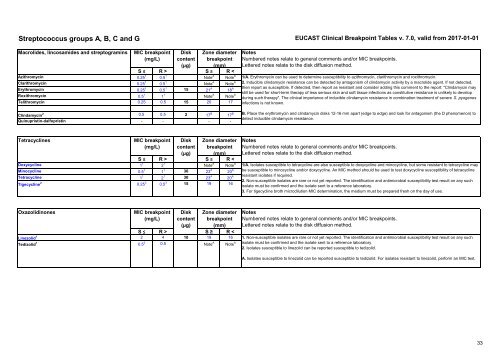European Committee on Antimicrobial Susceptibility Testing
v_7.0_Breakpoint_Tables
v_7.0_Breakpoint_Tables
Create successful ePaper yourself
Turn your PDF publications into a flip-book with our unique Google optimized e-Paper software.
Streptococcus groups A, B, C and G EUCAST Clinical Breakpoint Tables v. 7.0, valid from 2017-01-01<br />
Macrolides, lincosamides and streptogramins<br />
MIC breakpoint<br />
(mg/L)<br />
Disk<br />
c<strong>on</strong>tent<br />
Z<strong>on</strong>e diameter<br />
breakpoint<br />
(µg) (mm)<br />
S ≤ R > S ≥ R <<br />
Azithromycin 0.25 1 0.5 1 Note A Note A<br />
Notes<br />
Numbered notes relate to general comments and/or MIC breakpoints.<br />
Lettered notes relate to the disk diffusi<strong>on</strong> method.<br />
Clarithromycin<br />
Erythromycin<br />
Roxithromycin<br />
Telithromycin<br />
Clindamycin<br />
Quinupristin-dalfopristin<br />
Tetracyclines<br />
Doxycycline<br />
Minocycline<br />
Tetracycline<br />
Tigecycline<br />
Oxazolidin<strong>on</strong>es<br />
Linezolid 1<br />
Tedizolid 1 0.25 1<br />
0.25 1<br />
0.5 1<br />
0.25<br />
0.5<br />
-<br />
MIC breakpoint<br />
(mg/L)<br />
S ≤<br />
1 1<br />
0.5 1<br />
1 1<br />
0.25 3<br />
MIC breakpoint<br />
(mg/L)<br />
S ≤<br />
2<br />
0.5 2 0.5 1<br />
0.5 1<br />
1 1<br />
0.5<br />
0.5<br />
-<br />
R ><br />
2 1<br />
1 1<br />
2 1<br />
0.5 3<br />
R ><br />
4<br />
0.5<br />
Note A<br />
21 A<br />
Note A<br />
20<br />
17 B -<br />
Z<strong>on</strong>e<br />
breakpoint<br />
(mm)<br />
S ≥<br />
Note A<br />
23 A<br />
23 A<br />
19<br />
Z<strong>on</strong>e<br />
breakpoint<br />
(mm)<br />
S ≥<br />
19<br />
Note A Note A<br />
18 A<br />
Note A<br />
17<br />
17 B<br />
-<br />
diameter<br />
R <<br />
Note A<br />
20 A<br />
20 A<br />
16<br />
diameter<br />
R <<br />
16<br />
Note A 1/A. Erythromycin can be used to determine susceptibility to azithromycin, clarithromycin and roxithromycin.<br />
2. Inducible clindamycin resistance can be detected by antag<strong>on</strong>ism of clindamycin activity by a macrolide agent.<br />
then report as susceptible. If detected, then report as resistant and c<strong>on</strong>sider adding this comment to the report:<br />
still be used for short-term therapy of less serious skin and soft tissue infecti<strong>on</strong>s as c<strong>on</strong>stitutive resistance is<br />
during such therapy". The clinical importance of inducible clindamycin resistance in combinati<strong>on</strong> treatment of<br />
infecti<strong>on</strong>s is not known.<br />
B. Place the erythromycin and clindamycin disks 12-16 mm apart (edge to edge) and look for antag<strong>on</strong>ism (the<br />
detect inducible clindamycin resistance.<br />
Notes<br />
Numbered notes relate to general comments and/or MIC breakpoints.<br />
Lettered notes relate to the disk diffusi<strong>on</strong> method.<br />
1/A. Isolates susceptible to tetracycline are also susceptible to doxycycline and minocycline, but some resistant<br />
be susceptible to minocycline and/or doxycycline. An MIC method should be used to test doxycycline susceptibility<br />
resistant isolates if required.<br />
2. N<strong>on</strong>-susceptible isolates are rare or not yet reported. The identificati<strong>on</strong> and antimicrobial susceptibility test<br />
isolate must be c<strong>on</strong>firmed and the isolate sent to a reference laboratory.<br />
3. For tigecycline broth microdiluti<strong>on</strong> MIC determinati<strong>on</strong>, the medium must be prepared fresh <strong>on</strong> the day of use.<br />
Notes<br />
Numbered notes relate to general comments and/or MIC breakpoints.<br />
Lettered notes relate to the disk diffusi<strong>on</strong> method.<br />
1. N<strong>on</strong>-susceptible isolates are rare or not yet reported. The identificati<strong>on</strong> and antimicrobial susceptibility test<br />
isolate must be c<strong>on</strong>firmed and the isolate sent to a reference laboratory.<br />
2. Isolates susceptible to linezolid can be reported susceptible to tedizolid.<br />
If not detected,<br />
"Clindamycin may<br />
15<br />
unlikely to develop<br />
severe S. pyogenes<br />
15 2 2 D phenomen<strong>on</strong>) to<br />
Disk<br />
c<strong>on</strong>tent<br />
(µg)<br />
to tetracycline may<br />
30 of tetracycline<br />
30<br />
result <strong>on</strong> any such<br />
2 15<br />
Disk<br />
c<strong>on</strong>tent<br />
(µg)<br />
10 result <strong>on</strong> any such<br />
A. Isolates susceptible to linezolid can be reported susceptible to tedizolid. For isolates resistant to linezolid, perform an MIC test.<br />
33


